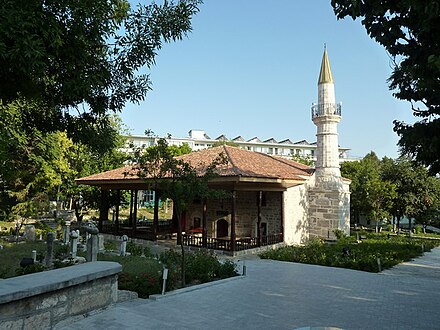Mangalia - city in Constanța County, Romania
Mangalia is a port city and tourist resort in south-eastern Romania.
Understand
The area has been inhabited since the Neolithic. In the 8th-6th centuries BC, it was colonised by the Greeks. The name of the city that they built was Callatis. In 71 BC the Romans came and conquered. Callatis was abandoned by the 7th century AD. Starting with the 13th century AD, documents speak of a new city, first called Pangalia, later Mankalia. It is believed that the Turks gave it its final name - Mangalia, since it was hard for them to pronounce Mankalia.
The beach is 600-m long and 50-150 m wide and has a very fine sand; the sea water is not very deep - 1 m by the shore to 200 m in the open sea and for this reason it is preferred by the children who cannot swim.
The city divides in 2 sections: Mangalia North that features the resorts Olimp, Neptun, Jupiter, Cap Aurora, Venus, Saturn and Mangalia South that features the commercial harbor as well as the shipyard.
Mangalia is also a balneoclimateric resort. Annual average temperature stand at 11.2°C. Lake Mangalia (whose surface stands at 261 ha) is supplied by rich sulfuric mesothermal water springs. They are employed in treating degenerative rheumatic diseases. Mangalia is the only maritime resort to have mineral water springs!
Get in
By train
Seven daily trains connect Constanta and Mangalia, going through the resorts on the Black Sea coast. From Mangalia to Constanta the first train leaves as early as 05:30. The last train departs at 19:30 arriving in Constanta at 20:46. From Constanta the first train bound for Mangalia leaves at 06:30, and the last one at 19:03.
In summer there are direct trains to Mangalia from Bucharest and other major cities in Romania.
By bus
There are frequent minibuses and buses on the Constanta - Mangalia route, especially in summer.
Get around
Mangalia is a small resort, spanning over 6200 ha. Most of the tourist attractions are reachable by foot. The resorts north of the city are reachable by buses and minibuses. Same goes for the hippodrome and the caves.

See
- Callatis Archeology Museum, jud. Constanţa near the stadium, Tel: 0241/753.580. Daily 08:00-20:00. It features a collection of Hellenistic coins, sculptures, ceramics, jewelry and tools dating back from the Greek, Roman and Dacian eras. Most items were recovered from the ancient city of Callatis. The facility also includes a library housing over one thousand volumes of archeology related books.

- Turkish Esmahan Sultan Mosque, 43.810278°, 28.583056°. One of the oldest mosques in Romania and the only medieval monument of Mangalia. Dating from 1573, the mosque was built by Esma, daughter of Sultan Selim II (1566-74) and wife of grand vizier (greatest minister of the Sultan) Sokollu Mehmed Pasha. It is still used by the local Muslim community and located in the centre of town within a large garden that also contains Ottoman grave stones. 2018-06-01
- Limanu Cave - it is not far away from the ancient Callatis.Throughout time it was used by smugglers, traders, seamen and as such has acquired a legend like status. The network of galleries of this cave resembles that of a city itself. The overall length of the galleries stands at 4 km. In the local folklore there are tales of this cave being endless and reaching out to fountains all the way to Turkey!
Do
Buy
Eat
Drink
Sleep
- Hotel Corsa (3*), strada teilor nr 11, +40 341 108 576. in the off season in springtime you get a very nice double room with exclusive Sea-View for less than €50. The breakfast there was great, a buffet with all-you-can-eat and drink. The hotel is near the city with nice restaurants and besides the old mosque from th 16th century. €45 double room
- Hotel New Belvedere, +40 372 085 882. A cosmopolitan looking place with beach access, pool, and restaurant featuring breakfast.
- Hotel Paradiso, Str. M.Basarab 3, +40 241 752 052. This seaside hotel tower really stands out and has a spa, pool, and restaurant.
Go next
Mangalia
mangalia.roConstanța
Primary administrative division